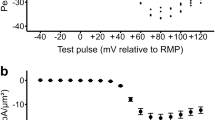Abstract
Calcium ions carry the inward current during depolarization of barnacle muscle fibres and are involved in the contraction process1. Intracellular ionized calcium ([Ca2+]i) in barnacle muscle, as in other cells, is kept at a very low concentration, against a large electrochemical gradient2,3. This large gradient is maintained by Ca2+ extrusion mechanisms. When [Ca2+]i is below the contraction threshold4, Ca2+ efflux from giant barnacle muscle fibres is, largely, both ATP dependent and external Na+(Na0+) dependent (see also refs 5,6). When [Ca2+]i is raised to the level expected during muscle contraction (2–5 µM)7, most of the Ca2+ efflux from perfused fibres is Na0 dependent; as in squid axons8, this Na0+-dependent Ca2+ efflux is ATP independent. Orthovanadate is an inhibitor of (Na+ + K+) ATPase9 and the red cell Ca2+-ATPase10. We report here that vanadate inhibits ATP-promoted, Na0+-dependent Ca2+ efflux from barnacle muscle fibres perfused with low [Ca2+]i (0.2–0.5 µM), but has little effect on the Na0+-dependent, ATP-independent Ca2+ efflux from fibres with a high [Ca2+]i (2–5 µM). Nevertheless, ATP depletion or vanadate treatment of high [Ca2+]i fibres causes an approximately 50-fold increase of Ca2+ efflux into Ca2+-containing lithium seawater. These results demonstrate that both vanadate and ATP affect Ca2+ extrusion, including the Na0+-dependent Ca2+ efflux (Na-Ca exchange), in barnacle muscle.
This is a preview of subscription content, access via your institution
Access options
Similar content being viewed by others
References
Atwater, I. et al. J. Physiol. Land. 243, 523–551 (1974).
Baker, P. F. Ann. N. Y. Acad. Sci. 307, 250–268 (1978).
Blaustein, M. P. Rev. physiol. biochem. Pharmac. 70, 34–82 (1974).
Ashley, C. C. Am. Zool. 7, 647–659 (1967).
DiPolo, R. & Caputo, C. Biochim. biophys. Acta. 470, 389–394 (1977).
Russell, J. M. & Blaustein, M. P. J. gen. Physiol. 63, 144–167 (1974).
Ashley, C. C. Ann. N. Y. Acad. Sci. 307, 308–329 (1978).
Blaustein, M. P. Biophys. J. 20, 79–111 (1977).
Cantley, L. C. et al. J. biol. Chem. 252, 7421–7422 (1977).
Bond, G. H. & Hudgins, P. M. Fedn Proc. 37, 315 Abstr. (1978).
Nelson, M. T. & Blaustein, M. P. J.gen. Physiol. 75, 183–206 (1980).
Dipolo, R. et al. J. gen. Physiol. 67, 433–467 (1976).
DiPolo, R. et al. Nature 281, 228–229 (1979).
Hagiwara, S. & Nakajima, S. J. gen. Physiol. 49, 807–818 (1966).
Simons, T. J. B. Nature 281, 337–338 (1979).
DiPolo, R. J. gen. Physiol. 69, 795–813 (1977).
Author information
Authors and Affiliations
Rights and permissions
About this article
Cite this article
Nelson, M., Blaustein, M. Effects of ATP and vanadate on calcium efflux from barnacle muscle fibres. Nature 289, 314–316 (1981). https://doi.org/10.1038/289314a0
Received:
Accepted:
Issue Date:
DOI: https://doi.org/10.1038/289314a0
Comments
By submitting a comment you agree to abide by our Terms and Community Guidelines. If you find something abusive or that does not comply with our terms or guidelines please flag it as inappropriate.



